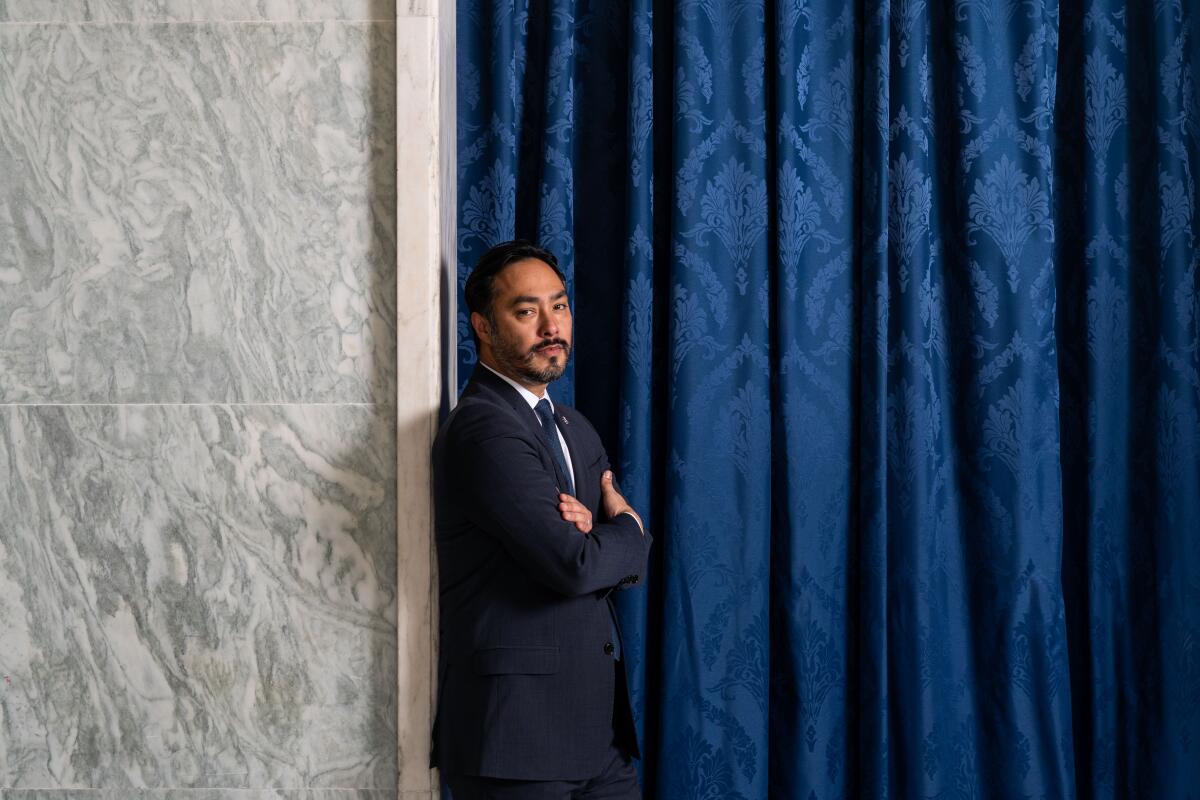Here’s why the first official figures on Latinos in the media look better than some expected

- Share via
Despite over-indexing in movie ticket purchasing and representing nearly a fifth of the U.S. population, Latinos remain underrepresented as employees in nearly every major industry related to media and entertainment, according to preliminary results of a federal study released Tuesday.
U.S. Latinos appeared to be overrepresented in one media sector alone, as service workers, the data found. Directors, editors, and executives with decision-making power were the least representative for Hispanics working in Hollywood, the news media and publishing. The study, conducted by the U.S. Government Accountability Office, is the first of its kind that focuses on the employment of Latinos in media.
Overall, Latinos in the United States made up about 12% of the workforce in media- and entertainment-related jobs, compared with the Hispanic population overall of about 18% in 2019, according to the GAO.
The study’s early findings were well anticipated in Hispanic watchdog and media circles. In recent years, Washington politicians and Hollywood heavyweights have adamantly pressed industry leaders to fix the representation deficit for the nation’s fastest growing and now largest minority subgroup.
On Tuesday, Rep. Joaquín Castro (D-San Antonio), who’s taken on the issue as a political cause, announced the figures during a speech at the National Press Club in Washington, D.C. Castro and fellow members of the Congressional Hispanic Caucus had requested the GAO look at available data on Hispanic employment in media and entertainment in October 2020.
“The media industry, and Hollywood in particular, is still the main image-defining and narrative-creating institution of American society,” Castro told the club. “This missing narrative, this systemic exclusion, it’s not only dangerous for Latinos, but it’s also dangerous for everybody.”
Castro called out major newspapers such as the New York Times, the Washington Post and the Los Angeles Times for having particularly poor rates of journalists who are Latino or Hispanic relative to their cities’ demographics.
“The fact is that some of America’s most renowned media institutions are the largest and longest perpetrators of cultural exclusion,” the congressman said. “With today’s GAO report, it’s now a matter of public record that Latinos are underrepresented in the media industry.”
Yet the GAO’s initial ratio in terms of raw employment figures is not as poor as previously presumed, and surprised some analysts and advocates. Researchers at UCLA and USC have steadily tracked front-of-camera and behind-the-camera visibility for U.S. Latinos in major studio productions, usually finding single-digit percentages as recently as last week.
Professor Chon Noriega, who was not involved in the study and is the former director of the UCLA Chicano Studies Research Center, cautioned that the GAO figures could leave a rosier impression than the reality of where Latinos stand in the media.
Significantly, the GAO did not delineate between jobs in English or mainstream-targeted media versus jobs in Spanish-language media, due to its data sets. Spanish-language media generally employ Hispanics in greater numbers and in some markets — such as Los Angeles — tend to dominate the tops of ratings.
Media activists have called for better representation expressly within mainstream-targeting storytelling in English, arguing that Spanish-language media do not readily reach the greater U.S. population. In the past, advocates have criticized major entertainment companies for padding their diversity figures by including Spanish-language programming and hiring in their internal analyses.
Spanish-language media is “doing some of the work of balancing things out, and they should be in there, because generally they’re not really treated as part of American broadcast culture,” Noriega said. “The same with music, right? But you have to parse out the difference between English- and Spanish-language.”
The GAO looked at responses to the American Community Survey of the U.S. Census Bureau, a random selection of households, from 2014 to 2019. The office compared those numbers with data collected by the U.S. Equal Employment Opportunity Commission between 2014 and 2018, from any related companies with four or more employees. (The study excluded employees of technology-specific, social media, and telecommunications companies.)
“If four Latinos get together and form a production company, whether or not the film ends up on TV or in a movie theater becomes secondary,” Noriega said. “Their presence in the industry has been duly noted, but not their marginality.”
Other data points jumped out at observers who responded to the report. Senior and executive managers were only 4% Latino or Hispanic in 2018, while professionals with degrees, including producers, directors, actors and journalists, were about 8% Latino. Service workers were 22% Latino in 2018, the GAO found.
The racial breakdown among Latinos (who can be of any race) is also noteworthy.
The GAO found that Latinos who were “white alone” accounted for 67% of the Hispanic workforce in the media in 2019. Black or Afro Latinos were 3% of the group; Asian Latinos made up 1%; Latinos who identified as American Indian (often a default for Indigenous-identifying people such as actor Yalitza Aparicio) were 2%; and Latinos who identified as “some other race” or “two or more races” made up 27% of the total. This final subgroup is usually composed of mestizo Latinos who list their heritage as part Indigenous and part European.
Brenda Castillo, president of the National Hispanic Media Coalition, said on Monday that the new figures belie a more complex landscape at the industry level. On the day after the 2021 Emmys broadcast, in which no non-white actor captured a performance award, the early circulation of the GAO figures felt dissonant, she said.
“I mean, did you look at the Emmys last night?” Castillo said. “We’re turning [close to] 20% of the U.S. population, and we’re definitely not 20% of employees in publishing, television, entertainment.
“Hollywood and the media companies, the majority are in California, where 40% of the population is Latino, and then the Emmys took place in L.A., which is 50% Latino,” Castillo added. “It’s just not moving fast enough.”
The GAO study came about in part in response to the anti-Latino gun massacre in El Paso in 2019, which prompted political leaders to question if Trump-era sentiments against immigrants fuel hateful or stereotypical depictions of Latinos in the public. Castro also noted Tuesday that states with large Hispanic populations such as California and Texas should not “subsidize exclusion” by offering tax incentives to media industries that don’t employ enough Latinos.
The GAO’s studies on Hispanic representation in media and entertainment are not finished. A second study is expected next year.
More to Read
The biggest entertainment stories
Get our big stories about Hollywood, film, television, music, arts, culture and more right in your inbox as soon as they publish.
You may occasionally receive promotional content from the Los Angeles Times.














